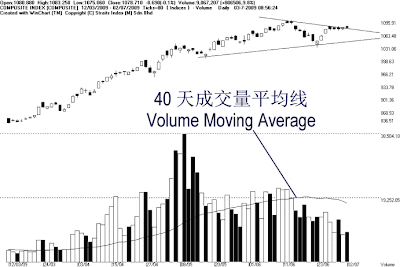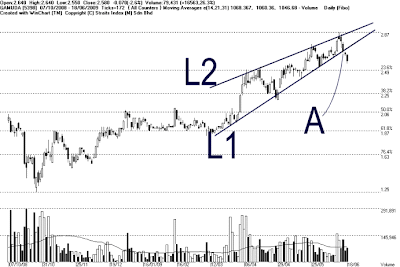40-day Volume Moving Average (40-day VMA level)
Chart 1: KLCI chart from 12/03/2009 to 02/07/2009, with 40-day Volume Moving Average.
As shown by chart 1, total market volume has been declining since 16th of June, and until now, it is still staying below the 40-day VMA level. This suggest that the inflow of fresh capital is relatively low, thus implying the market confidence is still weak. In other words, provided that the market volume is still below the 40-day VMA level, the KLCI is less likely to pick up its strength.
Analysis of the total market volume is important for if the overall market is weak, performance of the individual stock will be affected. This is why, we have always include volume analysis in our daily market analysis.

Chart 2: KLCI chart from October, 2005 to June, 2009, with 40-weeks Volume Moving Average.
As shown on chart 2, whenever the KLCI is having a bull run, volume is strongly above the Volume Moving Average, and if the KLCI is trending down, volume is below the Volume Moving Average. As indicated by A, the KLCI touched a new high of 1524.69, but volume on the other hand, failed to maintain above the 40-week Volume Moving Average, this is an important warning signal investors can not afford to miss.
When the KLCI is breaking new high, but volume is declining, this shows that the market rally is coming to an end, thus investors has to be prepared to take profit. It is because if the KLCI should have a correction, despite a mild correction, individual stocks would have a leveraged negative effect of the technical correction.
True meaning of Volume:
At any given time, every share issued by a listed company is being held by some investors, and therefore, when volume is increasing or declining, it does not mean an increasing or declining of share issued, but rather the frequency of trading, which means the changes of ownership from one investor to another. This may seem insignificant, but if the price should increase or decrease as a result of changing of ownership, there is an important message behind this.
Any positive factors could be the reasons of any price hike, but deep down, the mechanism which caused the price to move higher is because of a buyer is willing to pay a higher to obtain the share from a seller who is not willing to sell at a lower price. This is a sign of a positive capital inflow. If price should increased but volume failed to increase, this means that the inflow of fresh capital is relatively insufficient, thus the rally is unlikely to sustain. On the other hand, if price should increased with volume also increasing, this shows that the inflow of fresh capital is strong and the new buyers are willing to pay a higher price to buy shares from the sellers, thus off-setting the selling pressure, and therefore, the rally is well supported.
Last view this from another angle. Whenever a seller is selling his share, be it profit taking or cutting losses, the only reason for him to sell is because he is no-longer feeling confident with the stock at that price. In other words, the idea of selling is caused by his fear. Whenever a buyer is buying, whether a new position or topping up his positions, he must be confident with the stock at that particular price, in other words, it is his greed that gives his confidence. Therefore, when price should increase with volume increasing, it is a sign of more inflow of greed to offset the fear of the market, only then the rally can go on. (Study Chart 3).

Chart 3: TA – 4898 chart from 18/12/08 to 23/04/09, breaking above Ascending Triangle.
As shown on chart 3, price of TA formed an Ascending Triangle with L1 being the dynamic support while L2 being the resistance. As indicated by A, price of TA had a few attempts to break the L2 line, and finally breaking above the L2 line with substantial volume as indicated by B. The strong increased of volume suggests a strong inflow of fresh capital, sufficient to absorb the selling pressures at RM0.65 level. This is a typical strong bullish break out in technical analysis.
However, in reality, not all bullish break out is supported with strong volume. If price should break a resistance without strong volume, the break out signal is less reliable. However, investors can still treat the break out as a buy signal, but with cautions and proper trading plan, and must be prepared to cut loss if price should reverse after the break out.
Strong volume but price decline?
The increased of volume does not necessary give a positive signal. Sometimes, despite strong volume or fresh inflow of capital, but if the buyers are only willing to pay a lower price, and the sellers are more aggressive in selling because of stronger fear, price would fall with huge volume.
Strong volume causes a strong resistance.

Chart 4: Time 4456 chart from 12/03/09 to 02/07/09.
As indicate by A, price of Time Engineering Bhd increased on the 29th of June, and on the 30th of June, the rally continued, but soon selling began as the price was over-heated. It is rather normal to have technical correction after an over-heated condition. However, as indicated by B, volume on the 30th of June increased significantly. Therefore, the high volume associated with price fall actually suggests that selling pressure was stronger than the buying interests as buyers were only willing to buy at a lower price while sellers did not mind selling a bit lower aggressively. Therefore, this has increased the selling pressure, further dampen the negative sentiment.
With the KLCI entering a consolidation, many counters are having technical corrections, and even some has formed a short term downtrend. As long as price of these downtrend stocks is still staying below the downtrend line, investors should resist from buying. However, if the KLCI should break above 1095.91 resistance and price of the individual stock should break above the downtrend line, it would be a first trading buy signal, and of course, the best confirmation of such break out would be a strong volume associated with price breaking above the downtrend line.
Conclusion:
Volume analysis can not stand alone, it must be analyzed together with the price movement. If price and volume increases together, it means the buyers are willing to pay a higher price to obtain shares from the sellers, thus sustaining the rally. On the other hand, if price should decline with volume increasing, it suggests that the sellers are more aggressive in selling their shares without asking for more premium, and the buyers willing to buy only at a lower price, thus further dampen the sentiment of the downtrend.
Copyright © 2009 Straits Index (M) Sdn BhdImportant Disclaimer:These content provided by Straits Index (M) Sdn Bhd is solely for education and information purposes only, and do not suggest any investment advices. All information displayed are believed to be accurate and reliable. Interpretation of the data or analysis is at the reader's own risk. Straits Index (M) Sdn Bhd reserves the rights but obligations to update, admen, or even terminate the materials. 重要声明:以上的内容由海峡指数(马)私人有限公司提供,纯粹是教育性质, 并不是任何的投资忠告。所有资料显示认为是准确和可靠的。对数据或分析的解释和用途是在于用户自己的风险。海峡指数(马)有限公司持有保留及义务更新,甚 至终止材料的权利。
Source : WinChart, Straits Index (M) Sdn Bhd http://www.straitsindex.com/




























